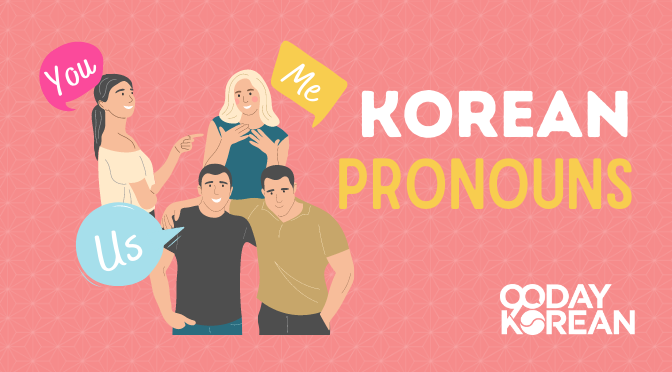In this lesson, we will cover everything you need to know about Korean pronouns. We’ll be discussing with you the different Korean personal pronouns and cover the first person singular and plural, second person singular and plural, third-person singular and plural pronouns in Korean.
Here are a few of the personal pronouns in Korean:
- I – 나 (na)
- You – 너 (neo)
- He – 그 (geu)
- She – 그녀 (geu nyeo)
- We – 우리 (uri)
- They – 그들 (geu deul)
This will be useful to use along with basic rules for Korean grammar, such as conjunctions, particles, and honorifics. By learning the Korean pronouns and how to correctly use them, you can elevate the look of your written and spoken sentences in no time.
Pronouns are important to the Korean language, so let’s get ready to understand how and when to use them.
Let’s go!
Below is a free PDF guide that you can download and take with you:
Get “Korean Pronouns” Free PDF Guide
Contents
Korean Pronouns
Korean pronouns work similarly to English pronouns. They are used in place of nouns to avoid repeating them over and over.
Korean speakers don’t use pronouns as often as English speakers do. In Korean, you don’t need to use pronouns for the sentences to have a whole meaning or thought. Therefore, you may not see pronouns very often in Korean sentences.
Let’s take a look at these example sentences.
병원에 가야겠어요. (byeongwone gayagesseoyo.)
I should go to the clinic.
도와 주셔서 고마워요. (dowa jusyeoseo gomawoyo.)
Thanks for your help.
Korean pronouns, unlike in English, have formal and standard versions.
For example, the pronoun “I” can be expressed formally as 저는 (jeoneun) and 나는 (naneun).
Pronouns in Korean
Pronouns in Korean are called 대명사 (daemyeongsa). There are specific words in Korean for the various types of pronouns.
The word for personal pronouns in Korean is 인칭 대명사 (inching daemyeongsa), while impersonal pronouns are 비인칭 대명사 (biinching daemyeongsa).
The indefinite pronouns in Korean are called 부정 대명사 (bujeong daemyeongsa), and relative pronouns are 관계 대명사 (gwangye daemyeongsa).
Korean pronouns list
In this lesson, we’ll present you with different Korean pronouns that are commonly used when having conversations. We’ll also give you how these personal pronouns in Korean look like when they are used with particles.
These are greatly helpful as you learn Korean and begin forming your own sentences both in written and spoken form. Below is a quick list of Korean personal pronouns to help you get started with speaking like native speakers.
| English Pronouns | Korean Pronouns | Grammatical Person |
|---|---|---|
| I/Me | 저 (jeo)나 (na) | First person – Singular |
| We | 저희 (jeohui)저희들 (jeohuideul)우리 (uri)우리들 (urideul) | First person – Plural |
| You | 너 (neo)자네 (jane)그대 (geudae)당신 (dangsin) | Second person Singular |
| You | 너희 (neohui)너희들 (neohuideul)너네 (neone)너네들 (neonedeul)자네들 (janedeul)그대들 (geudaedeul)당신들 (dangsindeul) | Second person Plural |
| He/She/It | 그 (geu)그녀 (geunyeo)*for female | Third person – Singular |
| They | 그들 (geudeul)그녀들 (geunyeodeul)*for female | Third person – Plural |
There you have the Korean pronouns. However, to go deeper in learning the different Korean pronouns, let’s move on to the next part of the lesson.
I in Korean
The personal pronoun “I” in Korean is expressed with either 나 (na) and 저 (jeo). The Korean pronoun 나 (na) is used to express the informal version of the personal pronoun “I”.
For example:
나는 일본어 배웠어요. (naneun ilboneo baewosseoyo.)
I learned Japanese.
On the other hand, the Korean pronoun 저 (jeo) is used for the formal version of the pronoun “I.”
For example:
저는 대학생이에요. (eoneun daehaksaengieyo.)
I am a university student.
It’s important to note that pronouns 나 (na) and 저 (jeo) can be both used with the standard ending 요 (yo) and formal ending -니다(-nida). However, 저 (jeo) can’t be used in an informal ending.
For example:
나는 대학생이야. (naneun daehaksaengiya.) (O)
저는 대학생이야. (jeoneun daehaksaengiya.) (X)
Both sentences mean “I am a university student” but the latter is incorrect.
I in Korean and Me in Korean (Singular) – First-person
Let’s start with the personal pronoun “I” in Korean, which is the first-person singular pronoun. You will want to use the formal “I” when speaking to those older than you or in a higher position than you, but also when meeting with someone for the first time.
Although you are talking about yourself, maintaining formality offers your respect to your speaking partner. Once a friendship has been established, you may drop to referring to yourself on an informal level.
I (formal) → 저 (jeo)
I (informal) → 나 (na)
Below is a list of the different forms of the Korean pronoun for “I”. We added the romanization for the rough approximation of the personal pronouns’ pronunciation. However, we recommend learning the Korean alphabet so you can pronounce these pronouns more accurately.
| English | Korean Pronouns | Formality |
|---|---|---|
| I (topic) | (jeoneun) (naneun) | formalinformal |
| I (subject) | (jega) (naega) | formalinformal |
| Me | (jeoreul) (nareul) | formalinformal |
| Me too | (jeodo) (nado) | formalinformal |
| My | (jeoui) (naui) | formalinformal |
Me in Korean
The personal pronoun “me” in Korean is expressed using the same Korean pronouns for “I”. This means the Korean pronouns 나 (na) and 저 (jeo) are also used to say “me” in Korean.
However, the particles used after them are different. The Korean particle 를 follows the pronouns 나 (na) and 저 (jeo) to express the personal pronoun “me” in Korean.
Here are example sentences:
저를 믿으세요. (jeoreul mideuseyo.)
Please trust me.
저를 소개합니다. (jeoreul sogaehamnida.)
Let me introduce myself.
나를 사랑해줘. (nareul saranghaejwo.)
Please love me.
나를 떠나지마. (nareul tteonajima.)
Don’t leave me.
My in Korean
Similar to “me” in Korean, the personal pronoun “my” is also expressed using the pronouns 나 (na) and 저 (jeo) in Korean. However, the Korean particle that follows is them is 의 (eui).
Here are example sentences of the pronoun “my” in Korean:
저의 꿈은 의사입니다. (jeoui kkumeun uisaimnida.)
My dream is to become a doctor.
저의 가장 친한 친구는 5명입니다. (jeoui gajang chinhan chinguneun 5myeongimnida.)
I have 5 best friends.
나의 강아지는 건강해요. (naui gangajineun geonganghaeyo.)
My dog is healthy.
나의 가족은 4명이야. (naui gajogeun 4myeongiya.)
There are four people in my family.
We in Korean
“We” in Korean is expressed using 2 different words. The usage of both pronouns depends on how formal you want to be with your sentence. You’ll use 저희 (jeohui) for formal “we” in Korean. But, you’ll use 우리 (uri) for informal “we” in Korean.
Below are example sentences:
저희는 같은 수업을 들어요. (jeohineun gateun sueobeul deureoyo.)
We take the same class.
저희 가게는 애견동반이 어렵습니다. (jeohi gageneun aegyeondongbani eoryeopseumnida.)
It is difficult to bring a dog with us.
우리는 거기 자주 가요. (urineun geogi jaju gayo.)
We go there often.
우리는 무엇을 할 수 있을까요? (urineun mueoseul hal su isseulkkayo?)
What can we do?
We in Korean (Plural) – First Person
The pronoun for “we” in Korean, both formal and informal, can be used for other pronouns such as “us” and “our” depending on the particle added to them.
We (formal) → 저희 (jeohui)
We (informal) → 우리 (uri)
When used together with the different common Korean particles, the Korean pronouns for “We” shape up like this:
| English | Korean Pronouns | Formality |
|---|---|---|
| We (topic) | (jeohuineun) (urieun) | formalinformal |
| We (subject) | (jeohuiga) (uriga) | formalinformal |
| Us | (jeohuireul) (urireul) | formalinformal |
| We too | (jeohuido) (urido) | formalinformal |
| Our | (jeohuiui) (uriui) | formalinformal |
Our in Korean
The possessive pronoun “our” in Korean is expressed using the same Korean pronouns for “we”. This means the Korean pronouns 저희 (jeohui) and 우리 (uri) are also used to say “our” in Korean.
However, the particles used after both pronouns are different. The Korean particle 의 follows the pronouns 저희 (jeohui) and 우리 (uri) to express the possessive pronoun “our” in Korean.
Here are some examples:
이 제품은 저희의 최신 모델이에요. (i jepumeun jeohiui choesin moderieyo.)
This product is our latest model.
우리의 생각은 하나다. (uriui saenggageun hanada.)
Our thoughts are the same.
Us in Korean
Similar to “our” in Korean, the personal pronoun “us” is also expressed using the Korean pronouns 저희 (jeohui) and 우리 (uri). However, the Korean particle that follows them is 를 (reul).
Below are example sentences:
저희를 도와주실 수 있으시겠어요. (jeohireul dowajusil su isseusigesseoyo.)
Could you help us?
저희를 봐주세요. (jeohireul bwajuseyo.)
Please look at us.
우리를 떠나지 마세요. (urireul tteonaji maseyo.)
Don’t leave us.
우리를 초대해 주셔서 고맙습니다. (urireul chodaehae jusyeoseo gomapseumnida.)
Thank you for inviting us.
You in Korean
There are a number of ways to say “you” in Korean. There is a formal, polite, and informal ways of saying “you” in Korean. The pronoun “you” also changes when used in a singular and plural form.
You in Korean (Singular) Second Person
While the usage of the “I” pronouns is quite straightforward, you have to be more careful with the second-person singular pronoun “you”. First, let’s go over what the pronouns for the singular “you” are:
You (formal) → 당신 (dangsin)
You (polite) → 그쪽/그대 (geujjok/gudae)
You (informal) → 너 (neo)
The singular second-person pronoun for “you” take the following forms when used together with particles:
| English | Korean Pronouns | Formality |
|---|---|---|
| You (topic) | (dangsineun) (geujjokeun) (gudaeneun) (neoneun) | formalpolitepoliteinformal |
| You (subject) | (dangsini) (geujjoki) (gudaega) (nega) | formalpolitepoliteinformal |
| You too | (dangsindo) (geujjokdo) (gudaedo) (neodo) | formalpolitepoliteinformal |
| Your | (dangsinui) (geujjogui) (gudaeui) (neoui) | formalpolitepoliteinformal |
You in Korean (Plural) Second Person
And here are the pronouns for “you” in plural form:
You (formal) → 당신들 (dangsindeul)
You (polite) → 그대들 (geudaedeul)
You (informal) → 너희, 너네, 자네 (neohui, neone, jane)
When used together with particles, the plural second-person pronoun for “you” shape up like these:
| English | Korean Pronouns | Formality |
|---|---|---|
| You (topic) | (dangsindeuleun) (geudaedeuleun) (neohuineun) (neoneneun) (janeneun) | formal politeinformalinformalinformal |
| You (subject) | (dangsindeuli) (geudaedeuli) (neohuiga) (neonega) (janega) | formalpolite informalinformalinformal |
| You | (dangsindeuleul) (geudaedeuleul) (neohuireul) (neonereul) (janereul) | formalpoliteinformalinformal informal |
| You too | (dangsindeuldo ) (geudaedeuldo) (neohuido) (neonedo) (janedo) | formalpoliteinformal informalinformal |
| Yours | (dangsindeului) (geudaedeului) (neohuiui) (neoneui) (janeui) | formal polite informalinformal informal |
Get “Korean Pronouns” Free PDF Guide
Why is “you” not used in the Korean language?
“You” is used in the Korean language, but it’s not used in the same way as in English. There are language and cultural differences that make it so there isn’t a direct translation.
There’s a caution you need to take when using the pronouns for “you”. You will not offend anyone by using 당신 or 그쪽, they are highly respective forms to use.
However, it is common in Korea to either use someone’s job title or family title, or alternatively, attach -씨 (ssi) or -님 (nim) to the name of the person you are speaking to.
In addition, you should not use the casual “you” pronoun 너 unless the person you are speaking to is the same age or younger and you two have a close relationship. Otherwise, it is nicer of you to refer to them by 오빠, 누나, or an alternative similar term.
Your in Korean
The pronoun “your” uses the same Korean pronouns used for “you.” This means the Korean pronouns 당신 (dangsin), 그쪽 (geujjok), 그대 (geudae), and 너 (neo) are also used for the pronoun “your.”
The difference between “you” and “your” is the Korean particle that follows them. For “your” in Korean, the particle used is 의 (eui).
He in Korean
“He” in Korean can be expressed as 그 (geu).
For example:
그는 선생님께 인사하기 위해 일어섰다. (geuneun seonsaengnimkke insahagi wihae ireoseotda.)
He stood up to bow to his teacher.
If you’re referring to a group of men or a group of people, you can add the plural particle 들 after it.
For example:
그들은 서로 인사했어요. (geudeureun seoro insahaesseoyo.)
They said hello to each other.
Him in Korean
The pronoun “him” in Korean is also expressed with the same Korean pronoun as “he” in Korean. This means the pronoun 그 (geu) is used for “him.”
However, the Korean particle 를 (reul) follows the pronoun 그 (geu), making it 그를 (geureul) to express “him” in Korean.
For example:
그를 언제 보았어요? (geureul eonje boasseoyo?)
When did you see him?
She in Korean
“She” in Korean is 그녀 (geunyeo).
For example:
그녀는 아주 착해요. (geunyeoneun aju chakaeyo.)
She’s very nice.
This is the same pronoun used when talking about a group of women.
Her in Korean
The pronoun “her” in Korean uses the same Korean pronoun as “she.” This means 그녀 (geunyeo) is used to express “her” in Korean.
However, the particle 를 (reul) follows 그녀 (geunyeo) and not 는 (neun). The Korean particle.
For example:
그녀를 향한 내 사랑은 변함이 없어요. (geunyeoreul hyanghan nae sarangeun byeonhami eopseoyo.)
My love for her remains the same.
They in Korean
“They” in Korean can be expressed using 2 pronouns. You can use 그 (geu) and 그녀 (geunyeo) and add 들 after them.
그들 (geudeul) is used if your talking about a group of men while 그녀들 (geunyeodeul) for a group of women.
The Korean pronouns for the third person pronouns “he”, “she”, and “they” take the forms below when used together with the Korean particles:
| English | Korean Pronouns |
|---|---|
| HeShe or They(group of women) | (geuneun) (geunyeoneun) |
| He isShe is | (geuga) (geunyeoga) |
| Him Her | (geureul) (geunyeoreul) |
| Him tooShe too | (geudo) (geunyeodo) |
| HisHer | (geuui) (geunyeoui) |
If you want to emphasize that you are speaking of “they” in the plural, simply add 들 (deul) after 그 (geu) or 그녀 (geunyeo). It is good to know these third-person pronouns in Korean just in case. However, do note that they are not usually used outside of certain written situations.
And there you have the pronouns for both singular and plural in the Korean language! The list may seem overwhelming at first, but as you have a few examples laid in front of you on the list, memorizing these pronouns should be quick and easy. So do not worry and instead trust as when we say you’ll learn them in no time. And when you feel ready and confident, we would love for you to share a sentence or two of your own choosing, including one of these pronouns, with us! Keep browsing our blog and website for more Korean grammar and phrases!








hello! is there a singular gender-neutral pronoun like they / them in korean? and how do you apply these pronouns to all forms?? thanks :))
Hi, Jel! ‘그’ can be used as a gender-neutral pronoun, and ‘그들’ for the plural form. ^^
Why is there polite form. If there is formal one .. when we will use the polite ones and formal ones .. and also can we just use one the informal anytime to anyone .. won’t it be wrong ??
Hi, Tshine! Please check this link (https://www.90daykorean.com/korean-honorifics/) for your question! ^^
Wow it’s really very helpful and easy to learn. I love the way of learning korean language. Thank you so much. I will suggest this to my friends too👍
Awesome! It’s our pleasure. We’re glad that it has been valuable to you. ^^
I want to clarify the pronounciation for the terms 나는 and 너는… I know it’s ‘naneun’ and ‘neonan’, but most of the times i hear them like ‘daneun’ and ‘deoneun’.
When 너는 나는 내가 is pronounced with ‘n’ sound then why so?
Hi, 자야! That’s because you’re not familiar with Korean yet. If you get used to Korean and know what words are used in context, you will be able to hear the pronunciation more accurately. ^^
Vero, a volte succede anche quando dicono “네” Al telefono e sembra “de”, credo sia solo la loro pronuncia
What about IT singular and plural
Hi, Jaimini! Singular ‘it’ is ‘그것’, and pleural form is ‘그것들’. ^^
Thank you
Sure, it’s our pleasure. ^^